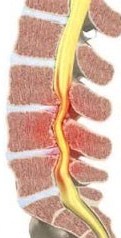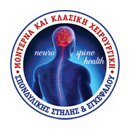
Definition
How is lumbar spinal stenosis classified?;
Lumbar spinal stenosis can be caused by several reasons, which may relate to all the anatomical elements of the spine.
The main causes are:
a) Calcified disc herniation, for example, old herniated discs that turned to bone with the support of calcium molecules
b) Ligamentum flavum hypertrophy
c) Small spinal joints hypertrophy
d) Osteophyte creation
e) Benign lateral synovial cysts
f) Spondylolisthesis (vertebrae displacement that results in the loss of straightening of the vertebral for a men that form the spinal canal)
g) Congenital stenosis due to achondroplasia
How is lumbar spinal stenosis classified? ;
Depending on the position of the lumbar spinal stenosis, it is classified as a central type or central canal stenosis, and a lateral canal stenosis where we observe the foramen narrowing where spinal nerve roots emerge from.
What are the symptoms of the lumbar spinal stenosis?;
Symptoms of the central canal stenosis are typical. Its main symptom is neurogenic claudication and it differs from ischemic claudication, which is caused by artery obstruction. This symptom entails the patient’s inability to walk for a prolonged period of time due to pain and/or numbness in the glutes and thighs. This symptom is characteristic because it subsides when the patient tries to sit or bend over, due to the temporary spinal canal expansion achieved through these positions. Usually, the worsening condition of the stenosis is manifested with the limitation of the distance walked until more symptoms appear. Finally, neurogenic claudication may be accompanied by symptoms from the independent nervous system, such as incontinence or urinary retention, constipation, or erectile dysfunction. The lateral canal stenosis symptoms are a similar to those of a herniated intervertebral disc, so they are manifested by sciatica with or without lower back pain.
What is the recommended lumbar spinal stenosis treatment?
All conservative treatment methods for lumbar spinal stenosis have failed, therefore only surgical treatment is recommended.
The recommended surgical treatment for both types of lumbar spinal stenosis (central canal and lateral canal stenosis) is nerve decompression (dural sac and/or lumbar roots) with an open or percutaneous (slightly invasive or closed technique) laminectomy, hemilaminectomy, or foraminotomy.
Regardless of which technique is selected, the most important factor affecting the outcome is the balance between the desired nerve decompression and the maintenance of the spinal stability since the expanded decompression may cause iatrogenic instability of the area. Stabilization with spinal fusion materials and bone implants (spinal fusion) is always required for the treatment of this condition. It can also be applied as a cautionary measure in case the decompression severity is estimated to cause instability of the lumbar vertebrae in order to prevent iatrogenic instability. It is mandatory in cases where both stenosis and spondylolisthesis occur since instability is a given and it is the cause of stenosis.







